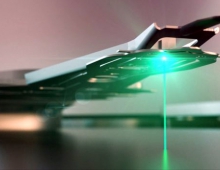
Scientists Unveil Million-Year Data Storage Disk
Nanotechnologists have designed and built a disk that can store data for a million years or more.
Typically, magnetic hard discs can store data for little more than a decade.
MIT Technology Review reports that Jeroen de Vries at the University of Twente in the Netherlands and his team have designed and built a disk capable of storing data for more than one million years without the media decaying, and they've performed accelerated aging tests (Arrhenius) to prove it.
They build a disk capable of storing information for this period of time. The disk is simple in conception. The data is stored in the pattern of lines etched into a thin metal disc and then covered with a protective layer.
The metal in question is tungsten, which they chose because of its high melting temperature (3,422 degrees C) and low thermal expansion coefficient. The protective layer is silicon nitride (Si3N4) chosen because of its high resistance to fracture and its low thermal expansion coefficient.
The disc was made using standard patterning techniques and stored data in the form of QR codes with lines 100nm wide. They then heated the disks at various temperatures to see how the data fared.
According to Arrhenius law, a disk capable of surviving a million years would have to survive 1 hour at 445 Kelvin, a test that the new disks passed with ease. Indeed, they survived temperatures up to 848 Kelvin, albeit with significant amounts of information loss.
There are caveats, of course. The theory behind accelerated aging only applies in very specific circumstances and says nothing about survivability in other cases. It?s hard to imagine the new disk surviving a meteor strike, for example. Indeed, it would be unlikely to survive the temperatures that can occur in an ordinary house fire.
But de Vries and co are confident that they can make even more robust data storage systems. Their work is an interesting step towards preserving our data for future civilisations.
MIT Technology Review reports that Jeroen de Vries at the University of Twente in the Netherlands and his team have designed and built a disk capable of storing data for more than one million years without the media decaying, and they've performed accelerated aging tests (Arrhenius) to prove it.
They build a disk capable of storing information for this period of time. The disk is simple in conception. The data is stored in the pattern of lines etched into a thin metal disc and then covered with a protective layer.
The metal in question is tungsten, which they chose because of its high melting temperature (3,422 degrees C) and low thermal expansion coefficient. The protective layer is silicon nitride (Si3N4) chosen because of its high resistance to fracture and its low thermal expansion coefficient.
The disc was made using standard patterning techniques and stored data in the form of QR codes with lines 100nm wide. They then heated the disks at various temperatures to see how the data fared.
According to Arrhenius law, a disk capable of surviving a million years would have to survive 1 hour at 445 Kelvin, a test that the new disks passed with ease. Indeed, they survived temperatures up to 848 Kelvin, albeit with significant amounts of information loss.
There are caveats, of course. The theory behind accelerated aging only applies in very specific circumstances and says nothing about survivability in other cases. It?s hard to imagine the new disk surviving a meteor strike, for example. Indeed, it would be unlikely to survive the temperatures that can occur in an ordinary house fire.
But de Vries and co are confident that they can make even more robust data storage systems. Their work is an interesting step towards preserving our data for future civilisations.





















